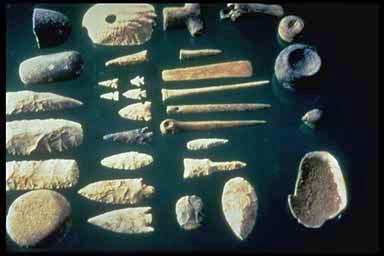
Copies of Stone Age tools were created and used in experiments to understand what imprints the various operations that use them leave on the edges of these tools, researchers at Tokyo Metropolitan University (TMU) reported on February 17. the science news website EurekAlert, citing the TMU press service.
Scientists have discovered that the combination of macroscopic and microscopic marks left on the blades of stone tools can reveal the purposes for which the stone’s sharp edges were used.
These marks help determine which tools were used to cut down the forest. By dating stone tools with corresponding markings on the sharpened edge, it is possible to determine when the ancients began using wood.
For our ancestors, every improvement in wood processing technology was revolutionary. If artifacts from the Paleolithic (early Stone Age) indicate that wood was used to make simple products: spears or throwing sticks, then artifacts from the later Mesolithic and Neolithic indicate much more complex technologies for using wood to build houses, make canoes, arches or wells. .
This demonstrates the availability of tools that allowed people to make increasingly complex wooden products, especially sharpened stone axes.
It is generally accepted that advanced wood processing technology existed during the Neolithic and Holocene, beginning approximately 10,000 years ago, but sharpened stone axes have been found at sites from much earlier times.
Many of these stage 3 isotopic marine artifacts (between 60,000 and 30,000 years ago) have been discovered along the coasts of Australia and Japan. This raised the question for archaeologists: what were they used for at such an early stage in the development of human society?
To solve this problem, a research team led by Associate Professor Akira Iwase of TMU sought to determine what marks can be left on the edges of sharpened stones when they are used for various tasks. Scientists have made replicas of tools that may have been used during the Early Upper Paleolithic (about 38,000 to 30,000 years ago).
Its edges were finished and sharpened using punching and grinding techniques available at the time. Although no handles have been found at Japanese sites from this period, researchers have used techniques from the Irian Jaya tribe of New Guinea to attach handles to the edges of stone to create adzes, axes, and chisels.
The research team conducted experiments using these tools for 15 different tasks, including cutting down trees, processing hides, and cutting up carcasses, as well as performing “non-productive” activities, such as carrying and trampling the tools.
They then carefully examined the cutting edges, looking for macroscopic and microscopic traces of these actions. Scientists have discovered that impacts such as those required to fell trees leave characteristic macroscopic cracks in the stone. In this case, the friction between the edge of the stone and the wood also forms marks, but they are microscopic and can also be used for diagnostic purposes.
While the cracks themselves cannot tell what caused them, the researchers found that simultaneous analysis of macroscopic and microscopic marks could provide reliable clues about whether the tools were used to fell trees.
The team believes that the presence of similar markings on the sharp edges of real artifacts from Marine Isotope Stage 3 sites would mean that early humans mastered carpentry technology much earlier than currently believed: 60,000 to 30,000 years ago.
This could change the understanding of the use of stone tools by Ice Age people and how such technology spread in different environments.
The team presented the results of their research in the article “Experiments with replicas of early Upper Paleolithic stone axes and adzes with sharp edges provide criteria for determining tool function,” published in the Journal of Archaeological Science.
Source: Rossa Primavera
I am Michael Melvin, an experienced news writer with a passion for uncovering stories and bringing them to the public. I have been working in the news industry for over five years now, and my work has been published on multiple websites. As an author at 24 News Reporters, I cover world section of current events stories that are both informative and captivating to read.
